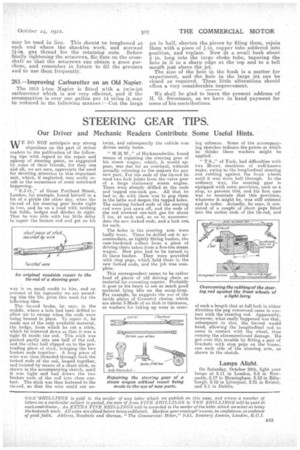• STEERING GEAR TIPS.
Page 29

If you've noticed an error in this article please click here to report it so we can fix it.
Our Driver and Mechanic Readers Contribute Some Useful Hints.
WE DO NOT anticipate any strong objections on the part af. .driver readers to the publication of the following tips with regard to the repair and upkeep of steering gears, as suggested by some of their friends, for they one and all, we are sure, appreciate the need for devoting attention to this important unit, which, if neglected, may easily result in the occurrence of same untoward happening.
" E.J.0„" of Great Portland Street, London, for example, found himself in a bit of a pickle the other day, when the tie-rod of his steering gear broke right in two, and he on a road with nothing but fields, hedges and ditches in sight. That he was able with but little delay to repair the broken rod and get on his way is no small credit to him, and on account of his ingenuity we are awarding him the 15s. prize this week for the following idea:
The tie-rod broke, he says, in the middle, where a hole had been drilled to allow air to escape when the ends were being brazed in place. To repair it, he made use of the only available material, the hedge, from which he cut a stick, which he trimmed down so that it was a tight fit inside the rod. This stick was pushed partly into one half of the rod, and the other half slipped on to the protruding piece of stick, bringing the two broken ends together. A long piece of wire was then threaded through both the forked ends of the rod, looped together, and twisted by means of a short stick, as shown in the accompanying sketch, until it was tight and had drawn the two broken ends of the rod into close contact. The stick was then fastened to the tie-rod, so that the wire could not un
twist, and subsequently the vehicle" was driven safely home.
" W.H.W.," of Heckmandwike, found means of repairing the steering gear of his steam wagon, which, it would appear, was due for an overhaul, without actually referring to the makers for any new part. For the ends of the tie-rod he used two fork joints from the valve gear of a large stationary steam engine. These were already drilled at the ends and tapped one-inch gas. All that he had to do with them was to pop them in the lathe and deepen the tapped holes. The existing forked ends of the steering rod were just sawn off, and the ends of the rod screwed one-inch gas for about 3 ins, at each end, so as to accommodate the new forked ends, and a lock nut. for each.
The holes in the steering arm were badly worn. These he drilled out to accommodate, as tightly fitting bushes, the case-hardened rollers from a piece of driving chain taken from a five-ton steam wagon. New pins had to be turned to fit these hushes. They were provided with stop pegs, which held them in the new forked ends, and the job was complete.
This correspondent seems to be rather fond of pieces of old driving chain as material for executing repairs. Probably it goes ta his heart to Bee so much goad material, lying idle on the scrap-heap. For example, he suggests the use of the inside plates of Coventry chains, which are about 3-32nds of an inch in thickness, as washers for taking up wear in steer. rig columns. Some of the accompanying sketches indicate the points at which he thinks these washers might be applied.
" T.S.," of York, had difficulties with two 30-cwt. machines of well-known make, owing to the longitudinal steering rod robbing against the front wheels until it was Worn half through. In the ordinary way, the steering gear is equipped with some provision, such as a. stop, to prevent this, and his first care was to ascertain that this provision, whatever it might be, was still existent and in order. Actually, he says, it consisted of a couple of short pegs fitted into the socket ends of the tie-rod, and of such a length that at full lock in either direction the peg concerned came in contact with the steering rod. Apparently, however, what really happened was that, subsequent to this, the tie-rod would bend, allowing the longitudinal rod to come in contact with the wheel, thus causing the aforementioned damage. I-Te got over this trouble by fitting a pair of brackets with stop pegs on the frame, one each side of the steering arm, as shown in the sketch.
Lamps Alight.
On Saturday, October 28th, light your lamps at 5.11 in Landon, 5.8 in Newcastle, 5.17 in Birmingham, 5.12 in Edinburgh, 5.18 in Liverpool, 5.21 in Bristol, and 6.1 in Dublin.






























